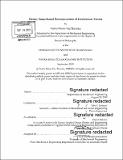Dense, sonar-based reconstruction of underwater scenes
Author(s)
Vaz Teixeira, Pedro Nuno.
Download1139519986-MIT.pdf (39.84Mb)
Other Contributors
Joint Program in Applied Ocean Science and Engineering.
Massachusetts Institute of Technology. Department of Mechanical Engineering.
Woods Hole Oceanographic Institution.
Advisor
John J. Leonard.
Terms of use
Metadata
Show full item recordAbstract
Three-dimensional maps of underwater scenes are critical to-or the desired end product of-many applications, spanning a spectrum of spatial scales. Examples range from inspection of subsea infrastructure to hydrographic surveys of coastlines. Depending on the end use, maps will have different accuracy requirements. The accuracy of a mapping platform depends mainly on the individual accuracies of (i) its pose estimate in some global frame, (ii) the estimates of offsets between mapping sensors and platform, and (iii) the accuracy of the mapping sensor measurements. Typically, surface-based surveying platforms will employ highly accurate positioning sensors-e.g. a combination of differential global navigation satellite system (GNSS) receiver with an accurate attitude and heading reference system-to instrument the pose of a mapping sensor such as a multibeam sonar. For underwater platforms, the rapid attenuation of electromagnetic signals in water precludes the use of GNSS receivers at any meaningful depth. Acoustic positioning systems, the underwater analogues to GNSS, are limited to small survey areas and free of obstacles that may result in undesirable acoustic effects such as multi-path propagation and reverberation. Save for a few exceptions, the accuracy and update rate of these systems is significantly lower than that of differential GNSS. This performance reduction shifts the accuracy burden to inertial navigation systems (INS), often aided by Doppler velocity logs. Still, the pose estimates of an aided INS will incur in unbounded drift growth over time, often necessitating the use of techniques such as simultaneous localization and mapping (SLAM) to leverage local features to bound the uncertainty in the position estimate. The contributions presented in this dissertation aim at improving the accuracy of maps of underwater scenes produced from multibeam sonar data. First, we propose robust methods to process and segment sonar data to obtain accurate range measurements in the presence of noise, sensor artifacts, and outliers. Second, we propose a volumetric, submap-based SLAM technique that can successfully leverage map information to correct for drift in the mapping platform's pose estimate. Third, and informed by the previous two contributions, we propose a dense approach to the sonar-based reconstruction problem, in which the pose estimation, sonar segmentation and model optimization problems are tackled simultaneously under the unified framework of factor graphs. This stands in contrast with the traditional approach where the sensor processing and segmentation, pose estimation, and model reconstruction problems are solved independently. Finally, we provide experimental results obtained over several deployments of a commercial inspection platform that validate the proposed techniques.
Description
Thesis: Thesis (Ph. D.)--Joint Program in Applied Ocean Science and Engineering (Massachusetts Institute of Technology, Department of Mechanical Engineering; and the Woods Hole Oceanographic Institution), 2019 Cataloged from PDF version of thesis. Includes bibliographical references (pages 143-153).
Date issued
2019Department
Joint Program in Applied Ocean Science and Engineering; Massachusetts Institute of Technology. Department of Mechanical Engineering; Woods Hole Oceanographic InstitutionPublisher
Massachusetts Institute of Technology
Keywords
Joint Program in Applied Ocean Science and Engineering., Mechanical Engineering., Woods Hole Oceanographic Institution.